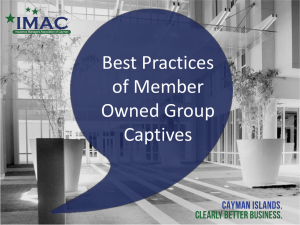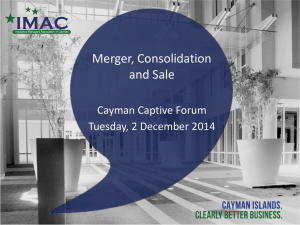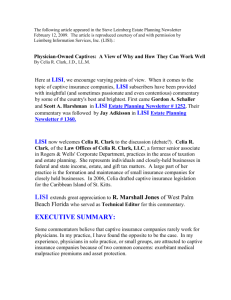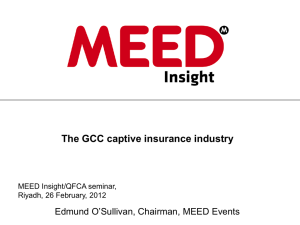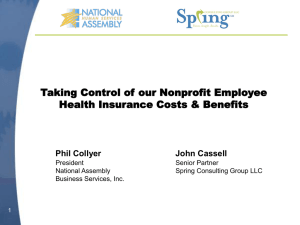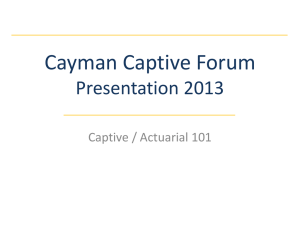The Use of Captive Insurance in Business and Estate Planning
advertisement
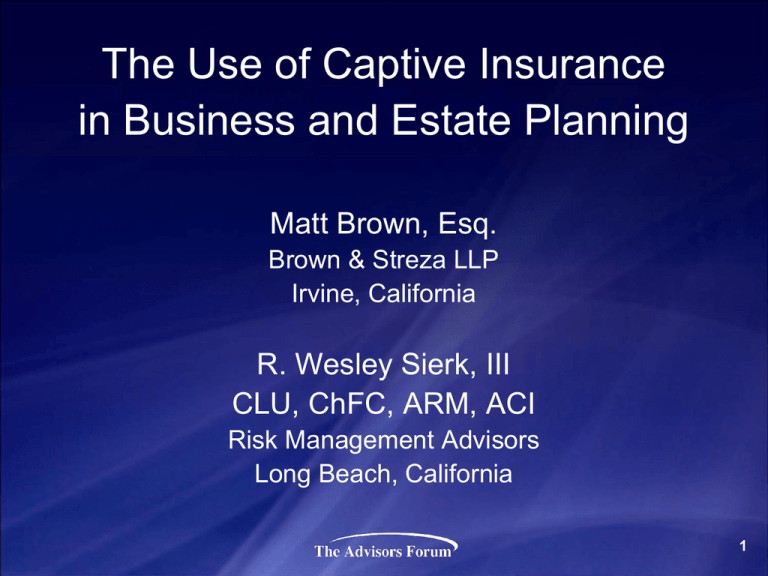
The Use of Captive Insurance in Business and Estate Planning Matt Brown, Esq. Brown & Streza LLP Irvine, California R. Wesley Sierk, III CLU, ChFC, ARM, ACI Risk Management Advisors Long Beach, California 1 Agenda • • • • • • • • • • What is a captive? Brief tax law history of captives Types of risks insurable in a captive Tax treatment of captives Jurisdiction (onshore versus offshore) Business planning opportunities Estate planning opportunities Implementation process Identifying prospects Potential problem areas 2 What is a Captive? • There are many types of captives, but for estate and business planning for closely-held businesses, the predominant form is a pure captive • A pure captive is either a parent-child captive or a brother-sister captive that primarily or exclusively writes business with parent or affiliate companies – A parent-child pure captive is owned directly by one or more companies that are its primary insureds (parent-subsidiary) – A brother-sister pure captive shares common ownership with one or more companies that are its primary insureds 3 What is a Captive? Parent-Child Owner Operating Company Casualty Coverage Premium Captive 4 What is a Captive? Brother-Sister (most common for closely-held businesses) Owner Premium Operating Company Captive Casualty Coverage 5 Why Use a Captive? • • • • Utilized by nearly 80% of the S&P Provides coverage for uninsurable risks Allows flexibility over claims management Creates wealth in underwriting profit (potential estate planning opportunity) • Protects assets and reserves • Provides limited tax benefits • Establishes “best practice” risk management procedures 6 Brief Tax History of Captives • What is Insurance? – Helvering v. Le Gierse, 312 U.S. 531 (1941) • Risk Shifting • Risk Distribution • Uninsurable 80-year-old woman purchased a life policy and an annuity policy from the same insurance company one month before death • Executor did not report death benefit on estate tax return • Supreme Court found no risk shifted because of offsetting positions; this was just an attempted tax dodge • First case to set forth the standard for true insurance as required to have both risk shifting and risk distribution 7 Brief Tax History of Captives • Revenue Ruling 77-316, 1977-2 C.B. 53 – Service creates the economic family doctrine – Risk must be transferred outside of the economic family to be true insurance – Key focus was on a lack of risk shifting, therefore this was not insurance and premiums were not deductible 8 Brief Tax History of Captives • Revenue Ruling 78-338, 1978-2 C.B. 107 – Adequate risk shifting with 31 unrelated companies – This was a group captive, not a pure captive, so this was not terribly helpful to closely held business owners – Service noted that no single member had a controlling interest 9 Brief Tax History of Captives • Explicit Rejection of Economic Family Doctrine – Carnation Company v. Commissioner, 640 F.2d 1010 (9th Cir. 1981) (taxpayer loss) – Clougherty Packing Co. v. Commissioner, 84 T.C. 948 (T.C. 1985) (taxpayer loss) – Humana, Inc. v. Commissioner, 881 F.2d 247 (6th Cir. 1989) (taxpayer victory) • Particularly explicit rejection of economic family doctrine. After a detailed discussion of prior courts rejecting the Service’s theory, the concluded that “under no circumstances do we adopt the economic family argument advanced by the government.” – Harper Group v. Commissioner, 979 F.2d 1341 (9th Cir. 1992) (taxpayer victory) • Affirmed tax court opinion, which stated, in part: “We have repeatedly rejected respondent's economic family theory “ 10 Brief Tax History of Captives • The Service did win in cases where the captive insured the parent (still problematic today), but lost in cases where the captive insured affiliates owned by a common parent • The taxpayer losses were never on the basis of the economic family doctrine, as the courts consistently refused to apply this bright-line test as too overinclusive and instead applied a facts & circumstances test 11 Brief Tax History of Captives • Revenue Ruling 2001-31, 2001-1 C.B. 1348 – Service determines it will no longer raise the economic family theory • Explicitly acknowledged that no court had fully adopted the economic family theory set forth in Rev. Rul. 77-316 – Analysis is now a case-by-case analysis – Service promised more challenges based on facts and circumstances • Focus is on risk shifting and risk distribution 12 Brief Tax History of Captives • Current Day – Safe Harbor • Rev Rul 2002-89 • Rev Rul 2002-90 • Rev Rul 2005-40 (very key) – 12 or more insureds can ensure risk distribution – Related parties that are separate taxpayers are considered separate premium payers – 50% third party risk is adequate 13 Types of Insurable Risk Insured Risks Uninsured Risks • • • • • • • • • • • • • • • • • • • Worker’s Comp General Liability Health Insurance Auto Collision Professional Liab. E&O D&O Builder’s Risk Earthquake Some D & O Punitive damage Excess E & O Deductibles Mold Construction Defect Exclusions Contract Claims Intentional Acts 14 Tax Treatment of Captives • 831(b) Captive – If premiums are less than $1.2 Million per year, no tax on premium income – Tax is paid on investment income at corporate rates • C-Corporations do not have the preferential individual income tax rate, so real estate is a bad investment (also may be too illiquid to be held inside of an insurance company). • High cash value life insurance may be an appropriate vehicle to defer tax – But we may simply be converting tax-free death benefit to taxable death benefit – Also need to watch out for corporate AMT on death benefit paid to a C-Corporation – Not a panacea, and should only be used as part of an overall plan; “selling” captives as a way to buy tax deductible life insurance is a good way to get into trouble with the IRS 15 Jurisdiction • • • • Onshore vs. Offshore Investment Flexibility Self-Procurement Tax Federal Excise Tax 16 Business Planning Opportunities • S-Corporations – Captive is a C-Corporation, so it is possible to create multiple classes of stock, vesting schedule, liquidation preferences, etc. • Key Employee Incentives – May be used to help fund nonqualified deferred comp – Ownership by key employees can be used to incentivize better risk management/create more of an owner mentality for key employees 17 Estate Planning Opportunities • Captive can be owned by children or trust for their benefit – GSTT efficient because GSTT doesn’t apply where not gift was made – Equity buildup can be used to provide seed money to defective grantor trust for future purchase of estate assets • Captive can be initially capitalized inside of children’s trust or gifted/sold later • Captive profits could potentially be used to fund life insurance more tax efficiently, either as a direct investment of the captive or by taking dividends and paying premium 18 Implementation Process • • • • • • • Feasibility study prepared by actuary Choice of domicile Corporate formation Underwriting process Policies written Regulatory application/license received Ongoing management costs 19 Implementation Process • First year costs: $75,000+ • Annual costs: $36,000+ for management fees, plus about $20,000+ more for audit, tax, licensing fees, actuarial fees • Third party risk costs for clients without 12+ insureds – 2.5%-4% cost for risk pool insurance purchases plus loss of use of funds while held by risk pool 20 Identifying Prospects • Ideally $2 Million or more in taxable income at the company level • Business must face substantial risks that are not entirely within its control (fortuity) • Estate planning motivation may help clients get over the complexity hurdle 21 Potential Problem Areas • • • Thinly capitalized Related party loan-backs Investment in life insurance – Can be a signal to the Service that this was a sham transaction/lacking in economic substance – Service has issued summonses for Aviva Life, AmerUs (now Aviva), and Indianapolis Life (now Aviva) related to ongoing scrutiny of captive promoters maintaining alliances with life insurance companies – Let the captive mature before buying life insurance, and be sure there is a substantial, nontax purpose (estate planning/buy-sell would count for this) • Inadequate third party risk – Less than requisite 12 insureds – Risk pools that pay no claims • • Heavy investment in the activities of affiliate companies (Service could use this as evidence in a sham transaction) Heavy investment in illiquid assets (not “looking like” an insurance company) 22 Potential Problem Areas • Accessing captives through any sort of “alliance”, “institute” or other title used to notate a consortium of individuals banded together to sell tons of life insurance through the aggressive marketing and inappropriate use of tax-advantage structures • This is a sure way to get a target painted on your back or your client’s back – No attorney-client privilege – The Service can and does get customer lists from these groups – These groups tend to be more reckless in their marketing materials since they need the “sizzle” to attract the attention of life insurance producers – The Service can and does use reckless marketing materials to hang taxpayers • Such as materials marketing captives as a way to deduct life insurance premiums and never pay tax on the proceeds • Like any advanced planning tool, captives should be accessed through an attorney as part of a comprehensive approach in arranging a client’s affairs – Attorney-client privilege will apply 23 Contact Matt Brown Partner Brown & Streza LLP Attorneys at Law 8105 Irvine Center Drive Suite 700 Irvine, California 92618 (949) 453-2900 (949) 453-2916 R. Wesley Sierk, III ACI, ARM, ChFC Risk Management Advisors, Inc. 110 Pine Avenue, Suite 310 Long Beach, Ca 90802 P 562.472.2846 x210 F 562.435.7886 CA Lic# OB36390 wsierk@riskmgmtadvisors.com m.brown@brownandstreza.com http://www.riskmgmtadvisors.com http://www.brownandstreza.com 24




